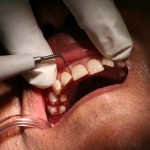
A range of adjuncts have been used to improve outcomes from nonsurgical periodontal treatment. These include low level lasers, antibiotics and non-steroidal anti-inflammatory drugs. Phytotherapy agents are derived from plants with therapeutic effects (antimicrobial, antiseptics, anti-inflammatory etc.) and many have been approved by the US Food and Drug Administration.
The aim of this review was to assess the effectiveness of local phytotherapeutics as an adjunct to scaling and root planing (SRP)
Methods
Searches were conducted in the Medline, Google Scholar and LILACS databases. Randomised controlled trials (RCTs) conducted in patients with chronic periodontitis receiving SRP alone versus SRP with adjunctive with phytotherapics or other natural products, which are not extracted from plants (eg, propolis). The primary outcomes were PPD and clinical attachment level change and the secondary outcomes were bleeding on probing (BOP) change, gingival index (GI) change, plaque index (PI) change and the occurrence of adverse effects. Two reviewers independently selected studies, abstracted data and assessed study quality using the Cochrane risk of bias tool. Overall strength of evidence was assessed using the GRADE (Grades of Recommendation, Assessment, Development and Evaluation) approach. Random-effects meta-analyses were conducted for CAL and PPD change after treatment.
Results
- 7 RCTs ( 5 split-mouth, 2 parallel) involving a total of 164 patients were included.
- No studies were considered to be at low risk of bias,3 were at unclear risk and 4 at high risk
- 6 studies contributed to a meta-analysis
- A significant overall reduction in PPD and CAL were seen in the SRP and phytotherapeutics group compared to SRP alone.
- PPD reduction = 0.65 mm, (95%CI; 0.47-0.83 mm); I2 = 41%,
- CAL gain = (0.79 mm, 95% CI;0.19- 1.38 mm; I2 = 92%,
- 2 studies did not report on adverse effects, 4 studies reported no adverse effects and 1 study reported discomfort due to placement of ‘chips’.
Conclusions
The authors concluded: –
In systemically healthy patients with periodontitis, the local use of phytotherapics as adjuncts to SRP may promote additional benefits in the reduction of PPD and clinical attachment level gain, when compared to SRP alone. However, these results must be interpreted with caution due to the small sample size, high risk of bias and heterogeneity of the studies.
Comments
A wide range of agents were included in this review with no studies using the same preparation. The included studies were small with a majority being of a cross-over design. This is of concern because of the risk of a cross-over effect and the future focus should be on studies of a parallel design. The included studies were small with the largest sample being 46 patients and none of the studies were at low risk of bias. The wide range of products used, the small sample sizes and the poor quality of the studies mean that the findings of this review should be interpreted with great caution. High-quality studies well reported studies with larger sample sizes are needed on these products before they sould be considered for use.
Links
Primary Paper
Moro MG, Silveira Souto ML, Franco GCN, Holzhausen M, Pannuti CM. Efficacy of local phytotherapy in the nonsurgical treatment of periodontal disease: A systematic review. J Periodontal Res. 2018 Jan 19. doi: 10.1111/jre.12525. [Epub ahead of print] Review. PubMed PMID: 29352465.
Other references
Original Review Protocol on PROSPERO

[…] post Phytotherapy as an adjunct to nonsurgical periodontal treatment? appeared first on National Elf […]